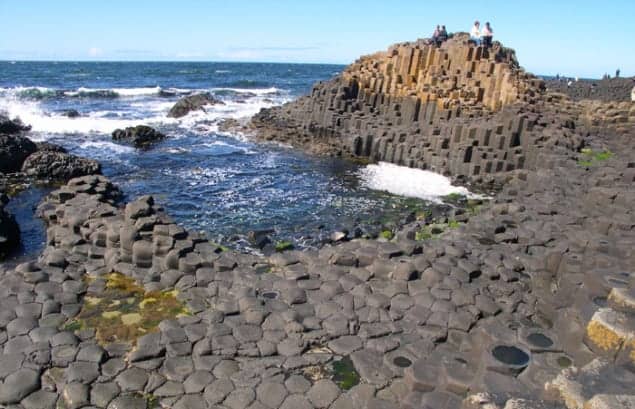
The formation of the spectacular hexagonal stone columns at Ireland’s Giant’s Causeway and similar structures around the world can be explained by two new models of how stone fractures. That is the claim of researchers in Germany who have created models to describe how the hexagonal columns emerge from an initial rectangular pattern of cracks in cooling lava. Beyond addressing a question that has intrigued geologists for centuries, the new models may also help in the study of cracking in other materials, such as cooling ceramics.
Located on the north coast of County Antrim, the Giant’s Causeway is renowned for its hexagonal columns of basalt, formed from an extensive lava plateau that was erupted around 55 million years ago. While local legend says the spectacular feature was built by the giant Finn MacCool, geologists know that the interlocking columns are a result of the lava shrinking as it cools – with the surface of the solidifying rock contracting faster than the material beneath. This results in stresses, which are relieved by cracks that spread from the surface downwards.
Why hexagons emerge, however, is not well understood because the cracks first form a rectangular pattern. According to team member Martin Hofmann of the Technische Universität Dresden, the rectangular pattern occurs because the maximum amount of energy is released from the cooling material when cracks develop at 90° to each other.
Y-junctions emerge
As the lava cools, however, the initially rectangular columns gradually transform into more hexagonal shapes, with the T-junctions of the fledgling fracture patterns evolving into Y-junctions over time. This is also seen in laboratory experiments with solidifying starch, which undergoes a similar transition in fracture patterns.
In their new study, Hofmann and colleagues explore how these fracture patterns evolve using two 3D models based on the theory of linear elastic fracture mechanics. This approach describes how crack patterns evolve in a uniform lava layer while ensuring that the optimum amount of energy is released in the process. This new approach, Hofmann says, “sets itself apart by its proximity to the mechanics of the actual process of this pattern shift”. The first of the two models takes a purely analytical approach, whereas the second is based on a 3D finite-element numerical simulation.
Both models trace the development of the joints from the initial cracking to the point at which the cracks extend all the way through the cooling lava body. The models suggest that the transition from T- to Y-junctions maximizes the energy released at each crack face. This, says the team, occurs when the growth of the fracture pattern goes from being dominated by the growth of individual cracks to a collective process of crack development throughout the material.
Completing the picture
“The necessary ingredients for the formation of basalt columns are fitting in place,” says Eduardo Jagla, a researcher at the Centro Atómico Bariloche in Argentina, who was not involved in this study. While the favourable energetics of the switch between T- and Y-junctions was already clear, he says, the numerical demonstration that fracture mechanics does indeed predict this transition helps to complete our understanding of why the hexagonal patterns emerge.
György Hetényi – a geophysicist at the ETH Zürich – agrees, calling the new model a “step forward”. Hetényi cautions, however, that there are other factors beyond pure fracture mechanics – including rock type, crystallization order and geological environment – that also need to be considered when studying column formation.
As well as helping to explain the fracturing process in solidifying lava, the researchers say that their new model could also be applied to the analysis of crack formation on drying lakebeds, as well as to help prevent or limit the cracking of ceramics as they cool.
The research is described in Physical Review Letters.



